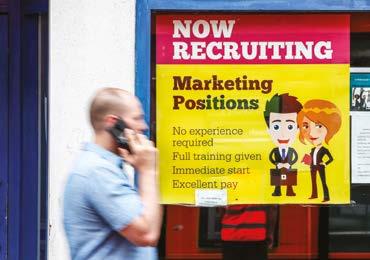
9 minute read
Skills Mismatch
Skills Mismatch: Mind the Gap between Training and Work
When it comes to professional skills, there is a gap between what companies seek and what workers provide. The consequences of this asymmetry should be a cause for concern throughout every step of the employment chain: companies, employees and (above all) the education system as a whole.
Advertisement
BY LIDIA BARATTA — JOURNALIST
Amidst the ongoing energy crisis, one of the most sought-after figures in the Italian job market is the specialist Internet of Things engineer. An expert who is able to spark a dialogue between the robots on the factory floor, collect and extract the resulting data and then analyse it to understand how best to reduce consumption and save on bills. Companies with one of these on their books hold on to them for dear life. Those looking to hire one fight to the death over the few industry professionals on the market with the necessary skills. This is only the most recent example of the mismatch between the skills possessed by employees and those in demand by employers.
According to a study by the Boston Consulting Group, the skills mismatch affects 1.3 billion people around the world and accounts for a loss of 6 percent of GDP every year. In OECD countries alone, this mismatch affects two in five workers. The greater the mismatch, the greater the impact on a country’s productivity. The COVID-19 pandemic has only aggravated this phenomenon, unleashing a wave of digitalisation and automation processes that regularly caught the job market entirely unprepared to cope and adjust. While the nature of employment is rapidly changing, the same cannot be said of training, where the skills required are often either entirely absent or else quickly become outdated. And not everyone is able to keep up. This “hidden tax” could end up costing us up to 11 percent of global GDP by 2025. “Over the last two years, aided by the pandemic, there has been a reallocation of labour, with shifts in the fringes of the market,” explains Maurizio Del Conte, a professor of employment law at Bocconi University. “When such things occur, you either meet them with a retraining pathway or else the mismatch intensifies.”
A MISMATCH ON MANY LEVELS
The overall “qualification mismatch” within the OECD at present, i.e. the gap between the skills required for a given job and those possessed by the employee, stands at 34.4 percent. In Europe it is 32.2 percent. If we look only at overqualified workers – those possessing excess skills for their role – the OECD average drops to 16.5 percent, and the European average to 15.3 percent. Among individual countries, the range goes from 29.1 percent in Turkey to 12 percent in Norway. Young people are more likely to have excessive academic qualifications compared to older generations. The same is true for migrant workers versus locals, the OECD has found.
The picture changes further if you take into consideration the countries with the highest number of low-skilled workers compared to demand in the job market. The worst off here are the United Kingdom and Ireland. But there is also another kind of mismatch; the one between the work an employee does and the academic curriculum they pursued. In this case, the OECD average stands at 31.7 percent, the European average at 32.2 percent. In Europe, there are 80 million “mismatched” employees, with academic qualifications in subjects that have nothing in common with their professions. In the UK alone there are 13 million such employees, in France a further 10 million, and in Italy nine. Germany, Austria, Finland and Switzerland fare far better on this metric.
“The difference between the various countries, in this case, is first and foremost the professional training system in place,” explains Luca Marcolin, an economist at the OECD. “Those countries that have a low academic mismatch are the ones with a dual system and a very strong apprenticeship pathway. This contributes to ensuring that a large percentage of employees are able to find work that matches their training.” The primary consequence of poor alignment between workers who are overqualified or whose jobs do not match their academic pathway is lower pay. These employees earn 24 percent less on average than colleagues whose employment matches their academic pathway. However, it is not the percentage of tertiary education graduates in a given country that determines the high percentage of “mismatched” employees. The average percentage of tertiary education graduates in both Germany and Italy, for example, is below the European average of 41 percent, yet the skill alignment levels are poles apart from each other. This is once more due to the training system. “There are many German students who stop before undergraduate studies, but who choose to pursue a professional training pathway instead which is closely linked to the business sector,” says Marcolin.
SKILLS SHORTAGE
The consequence of this asymmetry is the so-called “skills shortage”: employers unable to find the skills they need within the job market. This is a familiar condition in situations of economic growth or great upheaval, as new technologies are introduced that require skills that are not readily available. The OECD study has found that in recent years, the countries left behind the most by digitalisation, and with the education systems that have least adapted to the changes brought about by the digital transformation, are the same ones in which the skills shortage has increased. In turn, the shortfall in skills has reduced the economic performance of the individual states. The shortage of qualified hands in the United Kingdom in the mid-1980s, for example, reduced the growth in productivity by approximately 0.7 percent annually. And if there is an insufficient amount of qualified workers, it can also create barriers to the adoption of new technologies, limiting companies’ investments.

Female job seekers take notes as they attend an orientation session at a company booth during a job fair held for fresh graduates in Tokyo, Japan, March 20, 2016.
REUTERS / YUYA SHINO
A PROBLEM CALLED TRAINING
There are three factors to take into consideration when determining the extent of the skills mismatch: the quality of the education systems (school and university), continuing education and the efforts within the business sector to maintain the relevance of their employees’ skills. Not everything can be learned at school or university. This is why, the OECD explains, the solution to creating an economy of “adaptable workers that can take on current and future roles” lies in “lifelong learning,” an approach that “needs to take precedence for citizens to be able to move with the job market and keep up with the digital transformation.” In first place within the OECD for continuing education among the adult population is Norway, followed by Denmark. In last place is Greece, with enormous differences depending on the degree. As of today, only four in 10 highly qualified adults do not participate in formal or informal training. This number rises to eight in 10, twice as high, when it comes to low qualified adults. This means that 68 percent of adults with a low level of education within the European Union do not possess basic digital skills or do not use a computer. These numbers are at risk of increasing, especially when taking into account the ageing population and the subsequent rise in people of retirement age.
There is no question that there has been progress in recent years. But many countries are yet to catch up. In the most recent OECD survey, for example, only 20 percent of Italian adults said they had participated in a training programme over the previous year. The OECD explains that among the causes of the insufficient training among adults is the business sector. Small businesses often have limited resources to put towards training courses, not to mention that many of them have very limited experience in identifying the required skills among their workforce. Over 90 percent of large companies (with 250 or more employees) provide training courses for employees. This number drops to 76 percent among medium-sized companies and 57 percent among small companies.

A man walks past a recruitment shop in Luton, Britain August 6, 2020.
REUTERS / PAUL CHILDS
There is also the matter of the state’s ability to plan training, targeting those sectors in which it seeks to be competitive. Northern European countries, as well as the United States and Japan, have invested in training systems concentrated in large industrial hubs, which cascades down to the suppliers and auxiliary industries. In countries such as Italy, on the other hand, the structure remains fragmented. “The consequence is that there is no alignment with the actual needs of the business sector,” explains Maurizio Del Conte. “Italy spends more than half of its resources on foreign language courses, as well as a lot on basic IT skills. It’ll take more than a course in Microsoft Word to make you a champion of Industry 4.0.”
THE SOLUTIONS
Some countries have responded to the skills shortage through policies of targeted immigration, “importing” the missing workforce. Many governments have even sought to encourage more young people to register for specific subjects at university, setting quantifiable targets for the next decades. But in its “Skills Outlook” report, the OECD suggested that states invest primarily in continuing education plans, aligned with market changes, incentivising businesses to invest in internal retraining. Putting in place effective policies to address skills shortage, they write, requires an approach of “lifelong learning”. This means looking beyond the traditional classroom walls and lecture halls, to informal training. They recommend that governments pursue “strategic planning” to develop skills, by “providing resources to local and central governments,” and collaborations between the public, private and civic sectors.
The pathway to a functioning training system, according to Luca Marcolin, also moves through “an increased collaboration between schools and businesses to reinforce the professional training pathways, both in terms of quantity as well as quality.” He warns, however, that “more training is not always the solution. You can do lots of training that is of no benefit to the employer.” The investment should therefore be targeted in two ways: “Corporate training culture, and introducing diagnostic tools to assess business’ needs when it comes to skills.” There is also a plentiful supply of shorter online training courses. “One of the barriers identified by individuals when it came to training programmes is simply available time,” says Marcolin.

Lidia Baratta. Journalist, 36 years old, of Calabrian origins. Studied communication in Bologna and Rome, before attending the Walter Tobagi School of Journalism in Milan. In between, spent a short period studying in New York. She has worked at Linkiesta since 2012, working on employment and economic affairs, editing the weekly newsletter, “Forzalavoro”. She is among the presenters of the “Prima Pagina” radio programme on Italy’s Radio Tre. She is part of the team of journalists behind Good Morning Italia, collaborates on various publishing initiatives with Feltrinelli, and is among the contributing authors of the investigative journalism comic strip magazine, "La Revue Dessinée Italia". In 2016, she won the Gaspare Barbiellini Amidei Journalism Prize. Her previous bylines include Repubblica, L’Espresso, La Stampa and Vice.










